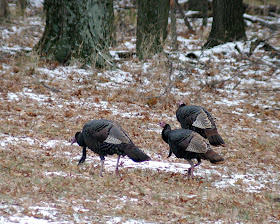 Photo by John Howard from Adams Co., OH.
Photo by John Howard from Adams Co., OH.
Photo from Wikipedia
The young are called poults and are cute little buggers. I saw a group of poults with mama turkey on a hike in Shawnee forest. Almost stepped on one. They are very camouflaged and will hide amongst the leaves and detritus on the forest floor.

The female turkey is called a hen.
An amazing thing I just learned-turkeys can have virgin births. Yep, called parthenogenesis. This has been discovered in domestic turkeys. This is uncommon and I am uncertain if it occurs in our Wild Turkeys. All the poults coming from the unfertilized hens were male. Turkeys have weird names for their parts. Hence, the title of my post. The snood hangs over the beak, the caruncles are the warty protuberances on the head and the wattle is the flap of skin under the neck. If someone says you have nice caruncles, it is not a compliment.
Turkeys have weird names for their parts. Hence, the title of my post. The snood hangs over the beak, the caruncles are the warty protuberances on the head and the wattle is the flap of skin under the neck. If someone says you have nice caruncles, it is not a compliment.
Three bearded males strolling for hens. Photo by John Howard.
The male turkeys also have beards that could make ZZ Top jealous. The long hair-like feathers grow from the center of their chest. They can grow an average of 9 inches long with a record of over 18 inches long. Ten percent of females can grow beards, too. These may be the poor hens who have to resort to parthenogenesis :)
 Males will display and fight over the hens. My friend John Howard captured this epic turkey battle down in Adams county last December. They will fly up and charge each other to "impress" the ladies. ; )
Males will display and fight over the hens. My friend John Howard captured this epic turkey battle down in Adams county last December. They will fly up and charge each other to "impress" the ladies. ; )So I hope you learned a few more facts about the everyday turkey. I sure did. :)


No comments:
Post a Comment